RetroLisa
---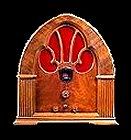 | 1940s
Music & Entertainment | |
|
___________________________________________________________________________________________________________
|
|
|
RetroLisa
__________________________________________
|
|
|
RetroLisa
| ___________________________________________________________________ | __ | _____________________________ | _______ | Musical Trends
styles
In the 1940s, the swing music of the big bands was popular. These bands were divided into three categories....sweet bands, swing bands and all-around bands. The Glenn Miller Orchestra was #1 in the sweet band polls.
Singers often launched their careers as big band vocalists before becoming solo acts. Doris Day sang with Les Brown, Helen O'Connell sang with Jimmy Dorsey, Perry Como performed with Ted Weems, and a skinny young kid from New Jersey named Frank Sinatra sang with the Tommy Dorsey band. Even Bing Crosby performed with Paul Whiteman before striking out on his own.
During the war, popular music was extremely nostalgic, focusing on the pre-war days of mom, apple pie and the girl back home. Bing Crosby's 1942 hit White Christmas owes much of its popularity to the fact that it was released at a time when America and the soldiers overseas were yearning for the simple joys of yesteryear.
Music In World War II
Big Bands & Big Names
Solid!
dancing
Swing dancing was born in the 1920s, when the Lindy-Hop was all the rage. In the 1940s, this energetic dance was known as the Jitterbug.
| |
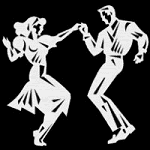
|
_________________________________________________
|
|
|
RetroLisa
| _________________________________________________________________ | __ | _______________________________ | _______ | For The Record
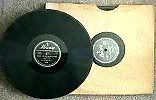
78 RPM records
Prior to 1948, music was released on 78 RPM records. These fragile shellac discs were ten inches wide and contained four minutes of music per side. Some labels also issued 12-inch records, which had a playing time of up to six minutes per side.
long-playing records
Long-playing records were introduced in 1948. These large vinyl discs used microgroove technology and a slower speed of 33 1/3 RPM, which resulted in an extended playback time of 23 minutes per side. LPs were originally available in both 10-inch and 12-inch formats, but the smaller size proved unpopular and was phased out in the 1950s. Long-playing records were designed with classical music in mind....at 23 minutes per side, an entire symphony could fit on one disc.

45 RPM records
45 RPM records were introduced in 1949. These discs were seven inches wide and made of durable vinyl plastic. Like the 78s that came before, this new format was perfect for short popular tunes.
albums
A typical 78 RPM record contained two songs. Longer musical selections and artist compilations required several discs. These boxed collections were called albums because the record sleeves folded out like the pages of a book.
When long-playing records were introduced in 1948, it became possible for an entire album to fit on one disc. Columbia released the first albums on LP later that year. Included in the collection were several classical pieces from the Columbia Masterworks series and a reissue of The Voice Of Frank Sinatra. Although they no longer resembled books, these records were and would forever be known as albums.
singles
White Christmas made its debut on Bing Crosby's radio show in 1941. The following year, it was recorded as a single and was featured in the movie Holiday Inn. After five years of strong sales, the original master recording was damaged beyond repair due to repeated pressings. A new master recording was made in 1947, with great care taken to recreate the sound of the original recording as closely as possible.
| |
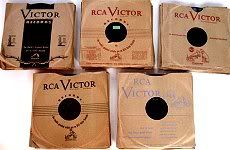
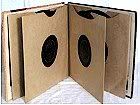
There was one problem with 78s....at four minutes per side, longer musical selections required several discs. This was truly the era of the box set!
What's on the turntable?
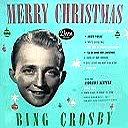
Merry Christmas - Bing Crosby
Decca, 1945, 78 RPM
Five-record set containing ten songs, including White Christmas and two selections with the Andrews Sisters
|
_________________________________________________
|
|
|
RetroLisa
| ___________________________________________________________________ | __ | _____________________________ | _______ | Live Entertainment
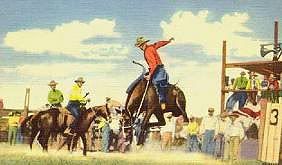
the rodeo
The first rodeos were held in the 1880s. When the days of the open range and trail drive were coming to an end, western towns hosted cowboy tournaments to preserve the ways of the cowboy before they were gone forever.
By the 1920s, the rodeo had become a national phenomenon, thanks to the creation of large shows offering big prize money. The western craze of the 1930s and 1940s helped the rodeo to become a major professional sport.

the circus
The traveling circus was a mainstay of summer entertainment in America. The animal menageries, clowns and thrilling acrobatic acts were enjoyed by children of all ages.
Some circus traditions were still alive and well in the 1940s, while others were falling by the wayside. Shows were still performed under the canvas big top, just as they had been for the past 100 years. The air was electric with the scents of popcorn, cotton candy, perspiration, sawdust and manure.
Change was in the air, however, and the circus parade was the first tradition to be eliminated. In the old days, circuses traveling by wagon advertised their arrival in town by parading their caravan down Main Street. Modern circuses traveled by truck and train. Although they tried to continue the tradition of the circus parade, increased auto traffic was making it difficult.
Train transportation was a problem during the war. Troop trains had priority, and the Office Of Defense Transportation was given the task of mapping out circus train schedules and routes.
During the 1940s, the Cole Brothers Circus and the Ringling Brothers, Barnum & Bailey Circus were the two largest shows in the United States. Clyde Beatty performed his wild animal act with the Cole Brothers and Russell Brothers circuses before forming his own Clyde Beatty Circus in 1945. The Wallendas, Cristianis and Flying Concellos performed dazzling tricks on the high wire and trapeze. Famous clowns included Lou Jacobs and Emmett Kelly as the "tramp clown" Weary Willie.
Emmett Kelly Museum
The Flying Wallendas
| |
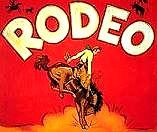

Weary Willie
|
_________________________________________________
|
|
|
RetroLisa
| ___________________________________________________________________ | __ | _____________________________ | _______ | For The Boys
Armed Forces Radio
In 1942, the government established the Armed Forces Radio Service to provide our soldiers with news, entertainment and a little touch of home. At first, radio shows and programs were recorded especially for servicemen and beamed out over short-wave radio. Later they were also recorded on transcription discs for shipment overseas.
programs
Armed Forces Radio
An Armed Forces Radio Holiday

V-Discs
The War Department created the V-Disc program in 1943 to provide our servicemen with the latest in recorded music. V-Discs were larger than regular 78s and were made of vinylite to withstand being shipped overseas. Some of the music came from radio broadcasts and concerts, and some was recorded especially for the V-Disc program. The most popular musicians of the era waived their usual royalties and worked during a musician's union strike to record V-Discs for the boys. The program was discontinued in 1949.
 Frank Sinatra Introducing A V-Disc Frank Sinatra Introducing A V-Disc
V-Discs
Frank Sinatra V-Discs
Bing Crosby V-Discs
V-Disc Records: Victory Music
Perry Como V-Discs
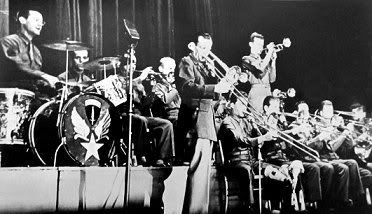
Glenn Miller Army Air Force Band
In 1942, popular band leader Glenn Miller was inducted into the army. He disbanded his civilian orchestra, formed the Glenn Miller Army Air Force Band, and almost single-handedly created the modern military music program.
"Next to letters from home, the Glenn Miller Army Air Force Band was the greatest morale builder we had in the European Theatre of Operations."
--General Jimmy Doolittle, Commanding General of the 8th Air Force
Glenn Miller Army Air Force Band
USO shows
The United Service Organization (USO) was formed in 1941 to give soldiers a "home away from home" while on leave. Before America entered World War II, USO clubs and traveling camp shows provided recreation and entertainment for servicemen based in the states. After we joined the fight, traveling shows and canteens accompanied our soldiers overseas. Thousands of volunteers performed in these shows, including Bing Crosby, Kay Kyser, Marlene Dietrich and Bob Hope. Between 1941 and 1947, the USO produced 428,521 camp shows.
USO Entertainment History
On The Road: USO Shows & Bob Hope
Marlene Dietrich & The USO
| |

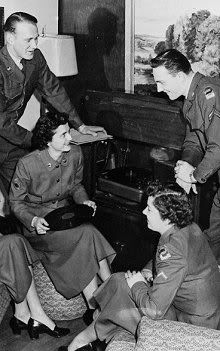
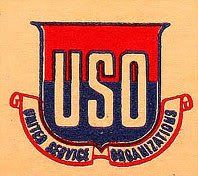
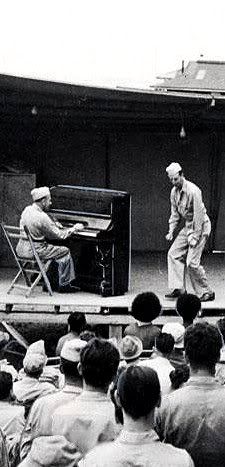
|
_________________________________________________
|
|
|
